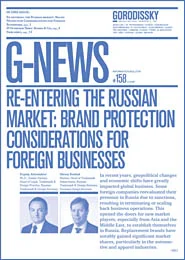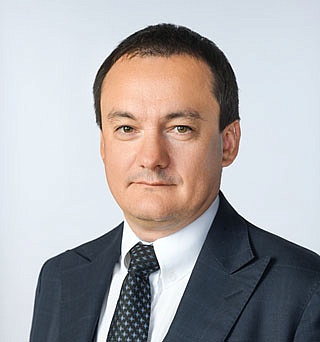Unlocking Design Protection in Eurasia: a Guide to the New Protocol
2 April 2025
Patentability of Eurasian designs
Filing requirements
Examination
Validity and invalidation
Disposal of Eurasian design rights
Enforcement of Eurasian design rights
Conclusion
The Eurasian design protection system is regulated by the Protocol on the Protection of Industrial Designs (Protocol) to the Eurasian Patent Convention (EAPC) and by related legal documents of the Eurasian Patent Organization (EAPO). Launched in June 2021, the Protocol now facilitates design protection by way of a unitary Eurasian design patent valid in the territory of eight jurisdictions: Armenia, Azerbaijan, Belarus, Kazakhstan, Kyrgyzstan, Tajikistan, Turkmenistan, and Russia.
A remarkable feature of the Eurasian design patent is its direct validity in the territory of all mentioned countries; after issuance of the design patent, no additional validation by respective national state authorities is required.
The Eurasian design protection system has shown great development since its launch in 2021. According to the 2023 Annual Report by the EAPO, the number of applications for Eurasian designs increased by 58% that year, and the geography of users expanded to 26 countries.1
Patentability of Eurasian designs
A Eurasian design is patentable if it represents a solution in the outer appearance of an industrial or handicraft article that is new and original in its essential features.
Designs of any kind of article can be patented, including, but not limited to, packaging, labels, composite articles, sets of articles, typeface, GUI, etc.
Solutions contrary to public interests or against principles of humanity and morality in at least one of the Member States of the Protocol are not patentable.
The Eurasian system defines further nonpatentable solutions, for example, those that include, reproduce, or imitate official state symbols or names, symbols of international organizations or official names, or pictures of cultural heritage sites. However, such elements can still be included in Eurasian design as non-protectable elements if the consent of the respective competent bodies or respective right holder is obtained.
One novelty of the Eurasian design system, after January 01, 2024, is the possibility to obtain protection for designs that are potentially conflicting with third parties’ earlier trademarks if consent from the respective trademark holder is obtained.
Obtaining protection for designs that are potentially conflicting with third parties’ copyrights is also allowed if consent from the respective right holder is obtained.
Filing requirements
An application for a Eurasian design patent is to be filed with the Eurasian Patent Office (EAPTO). Applicants not domiciled in Member States of the Protocol should be represented by Eurasian Patent Attorneys duly registered with the EAPTO.
One of the features that makes the Eurasian design system similar to the Hague International Design System is the possibility of including up to 100 designs in a single application, provided that all claimed designs relate to one and the same class of international classification.
The maximum number of representations acceptable for filing for one design is limited to seven.
The Eurasian design system accepts partial designs, namely, it is allowed to show the unclaimed elements with dotted lines or color marking/shading/blurring.
As of November 1, 2022, the Eurasian design system allows for the submission of a 3D model along with application materials. It is used just for examination purposes and not for determining the scope of legal protection, which is determined exclusively based on representations of the design.
Also, as of December 1, 2021, priority documents for design applications are accepted by the EAPTO through the WIPO Digital Access Service (DAS).
Examination
An application for Eurasian design undergoes preliminary and substantive examination.
The preliminary examination focuses on verifying the compliance of the design application with formal requirements, but also the Examiner checks if the claimed design does not contradict public interests and principles of humanity and morality in the Member States.
The application is published within a month from the date of forwarding the positive results of the preliminary examination. It is important to note that no deferment of publication is provided.
Third parties are entitled to file an opposition against the Eurasian design application within two months from the application publication date.
If an opposition is filed, the Examiner will check the compliance of the claimed design with respective patentability conditions, which serves as a ground for opposition, but only in frames of materials and information submitted with the opposition.
In the case of a positive preliminary examination, the EAPTO conducts a substantive examination with due account of oppositions, if filed by third parties.
Due to recent amendments of the Patent Instruction, the list of grounds that the Examiner checks at the substantive examination has considerably expanded.
Thus, the Examiner will check if the claimed design represents an obviously non-original solution, with essential features that are not of a creative nature. This check, however, does not imply a deep information search but is based on the information available to the Examiner.
Furthermore, the Examiner will check if the claimed design represents a solution with a combination of essential features already known from the information available to the Examiner and/or received by conducting other checks during substantive examination. Again, this novelty check does not imply conducting a deep informational search.
Starting from January 1, 2024, the Examiner also checks whether the claimed design conflicts with:
- Identical and/or confusingly similar trademarks registered or applied for registration and published on the territory of at least one Member State with earlier priority;
- Identical and/or confusingly similar copyrighted objects if the rights for such objects exist in the territory of at least one of the Member States.
Also, starting from January 1, 2024, the Examiner checks if the claimed design can be considered as a deceptive solution with respect to the product manufacturer, place of production, or with respect to the product for which the solution serves as a container, packaging, or label.
If the grant of a patent is refused, the applicant has the right to transform the Eurasian application into national design applications.
Starting January 1, 2023, Eurasian design patents are issued in electronic form. However, a Eurasian design patent on paper can still be issued upon an applicant’s request.
Validity and invalidation
The term of validity of the granted Eurasian design patent constitutes five years (counting from the application filing date). There is no need to pay annual fees to keep the Eurasian design patent in force; the maintenance is effected by payment of a fee for a five-year extension of the validity term. The extension is made in respect of all Member States where the patent is valid; the maximum term of validity is 25 years.
The Eurasian design patent can be challenged and held invalid in full or in part as a result of an administrative procedure before the EAPTO or proceedings in the national court(s) or other competent bodies of Member States.
The invalidation of the Eurasian design patent as a result of administrative procedure applies to all Member States.
From January 1, 2024, the term for filing an administrative invalidation action increased up to three years (counting from the date of publication of Eurasian design patent). Such a considerable increase in the period (initially six months) for filing an administrative invalidation demonstrates the wish of the EAPTO to concentrate consideration of invalidation actions within the Eurasian system and to ensure in this way the uniform application of Eurasian legal provisions.
After the expiration of the term for filing an administrative invalidation, the Eurasian design patent can still be held invalid by national court(s) or other competent bodies of Member States. In this case, the invalidation procedure is regulated by the legal provisions of a respective Member State. However, the validity of the Eurasian patent is assessed based on Eurasian legal norms.
The invalidation of the Eurasian design patent as a result of proceedings in national court(s) or other competent bodies of Member States applies only to the territory of the Member State where such invalidation decision was issued.
Dispute resolution
The Eurasian design system provides for the possibility, in some cases, to apply for a mediation procedure, which received a more detailed regulation starting from October 1, 2024.
A mediation procedure can be applied, in particular, for the case of:
- An opposition filed against a Eurasian design application based on a conflict with a prior trademark or copyright;
- An appeal against the refusal to issue a Eurasian design patent based on a conflict with a prior trademark or copyright;
- An administrative invalidation action against a Eurasian design patent based on a conflict with a prior trademark or copyright.
A mediation procedure primarily aims to reach an agreement between the applicant/patent holder and the person who initiated an opposition or invalidation action and/or the person whose consent is required to obtain a Eurasian design patent.
In case of reaching a mediation agreement, the latter is to be approved by the EAPTO if such an agreement does not contravene the legal regulations of the Eurasian Patent Organization.
Disposal of Eurasian design rights
Since 2021, there have been no significant changes to the Eurasian Patent Convention and Patent Instruction regarding the disposal of Eurasian design rights.
The Eurasian Patent Convention offers various disposal methods for Eurasian design rights, including assignment, licensing, pledge, and other options permissible under Member States’ local laws.
Assignment
Eurasian industrial design assignments must cover all Member States where the patent is valid; partial assignments are prohibited. Assignments can include one or more industrial designs covered by the patent but cannot cause consumer confusion about the product’s origin or manufacturer.
Licensing
A license agreement for Eurasian industrial designs can be made for any Member State where the patent is valid.
Pledge
Eurasian design rights can be pledged through a security of interest agreement. Parties can specify when the pledge begins; if unspecified, it starts upon agreement execution. Mandatory provisions include the subject of the agreement, assessment results of the pledged industrial design’s exclusive right, substance, value, and duration of the secured obligation.
After the security of interest agreement is concluded, the Eurasian design owner shall still have the right to dispose of the exclusive right to the Eurasian design in order to fulfill the pledge obligation, if otherwise is not envisaged by the agreement.
Recordals and publication
Under the Eurasian Patent Convention, assignment and security of interest agreements must be registered with the Eurasian Patent Office to be valid for third parties.
License agreements must be registered with the national Patent office of the respective Member State. Upon registration, the national office promptly notifies the Eurasian Patent Office.
The Eurasian Patent Office publishes details of assignments, licenses, and security of interest agreements in its official Bulletin.
Enforcement of Eurasian design rights
The owners of Eurasian designs can enforce their rights according to national laws and procedures applicable to national industrial designs in the Member State where the infringement occurs.
The exclusive right to the Eurasian design is recognized and valid throughout all Member States, with legal protection based on the essential features reflected in the product images.
Temporary legal protection
As per the Patent Instruction, Eurasian designs enjoy temporary legal protection across all Member States. This protection extends to the combination of essential features reflected in the product images published by the Eurasian Patent Office. The owner of the Eurasian design shall be entitled to claim reasonable compensation from those using the claimed industrial design between the dates of publication of the application and the granted patent, as per the national legislation of the Member State where the use occurred. However, temporary legal protection does not apply if the Eurasian design application was rejected without further appeal options or considered withdrawn.
Conclusion
Recent developments of the Eurasian design protection system demonstrate that the Eurasian Patent Office is moving towards becoming a full-examining authority with respect to industrial designs, thus increasing the reliability and efficacy of the Eurasian design patent.
In the context of a design patenting strategy in the Eurasian region, applicants may take into consideration obtaining a unitary Eurasian design patent through a flexible centralized procedure before the Eurasian Patent Office, with the same validity and enforceability as national design patents.











